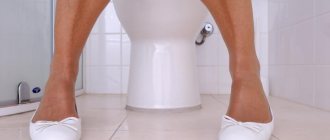What is daily diuresis
Daily diuresis in adults and children is the volume of urine excreted per day. This indicator reflects the functioning of the kidneys and provides indirect information about the condition of the heart, liver, and endocrine system. The rates of fluctuations in diuresis in adults depend on:
- amount of liquid drunk;
- nature of nutrition;
- ambient temperature.
The definition of urinary output also includes the number of urinations during the day and at night. When examining urine, its density is determined, which indicates the capacity of the kidneys. A type of study is the Zimnitsky analysis, hourly diuresis.
Establishing diagnosis
The normal frequency of urination is 6 to 8 times. If this indicator is exceeded significantly and additional symptoms appear: pain, unnatural impurities in urine, and so on, you should immediately consult a doctor. A comprehensive diagnosis will be required. It may include the following activities:
- Urine is collected for general analysis. Its physical and chemical characteristics are assessed. The presence of blood components indicates the presence of stones in the bladder or the development of inflammatory processes.
- Examination of a smear from the urethra. With its help, it is possible to detect the presence of pathogens of sexually transmitted diseases.
- Blood analysis. It is used to determine the presence of an inflammatory process.
- Ultrasound of the urethra and nearby organs. The specialist evaluates their condition and identifies all present pathological changes that could cause increased urine output.
- Urethrography. With the help of such a study, the performance of the urethra is determined.
- Urography of the kidneys. Allows you to identify disturbances in the process of urine production, as well as structural changes in kidney tissue.
- Computer or magnetic resonance imaging. Allows you to most accurately determine the diagnosis. Such techniques allow you to obtain images of internal organs in all possible projections.
Correct diagnosis carried out in a timely manner will allow us to identify diseases accompanied by increased diuresis in the early stages. Otherwise, the disease will enter the chronic stage, which is fraught with its severe course and the development of various complications.
Table of urinary excretion indicators for men and women
For daily diuresis, the norms fluctuate slightly. In adult men and women the rate is almost the same; in children it varies by age.
| Age | Urine, ml |
| 1-10 days | 100 |
| Up to 2 months | 400 |
| Up to a year | 500 |
| Up to 3 years | 600 |
| Up to 5 years | 700 |
| Up to 8 years | 600-800 |
| Up to 14 years old | 800-1200 |
| Adult men | 1000-1800 |
| Adult women | 1000-1500 |
| After 60 years | 1500-2000 |
Hourly diuresis varies depending on physical activity and diet. Until 3-4 o'clock in the afternoon it is higher than in the evening.
Day and night indicators
During the daytime, in an adult, all vital processes of the body are at the peak of their activity. Therefore, during wakefulness, the formation and excretion of urine occurs much more intensely. If we consider the quantitative indicators of daytime and nighttime diuresis, then its ratio is 4 to 1. That is, with normal functioning of the kidneys and other organs of the genitourinary system, 4 times less urine should be released during sleep than during the day.
Violation of the specified proportion in the direction of increasing the amount of urine that is released at night indicates such a pathological indicator as nicrotria.
This symptomatology indicates the possible presence of the following diseases:
- nephrosclerosis;
- pyelonephritis of bacterial origin;
- diabetes;
- glomerulonephritis.
People who produce a large amount of urine during the day at night complain that they wake up at least 4-6 times a night to go to the toilet. At the same time, portions of urine differ in significant volume. Before each bowel movement there is a feeling of fullness of the bladder. To establish a violation of the norm of daily diuresis, a simple algorithm is used to calculate the amount of urine that was released over a certain period of time.
Over the course of 24 hours, a person undergoing a diagnostic examination urinates each time in a separate container, which indicates the time of going to the toilet. The period from 7 pm to 7 am, during which biological fluid was released, refers to nocturnal diuresis. The daily volume of urine is recorded according to a similar principle, but only from 7 pm to 7 pm. In the laboratory, measurements of the collected material are taken, and using a special formula, a specialist calculates the percentage of the volume of night and day urine.
Normal urination
Data on the urge to emit urine are average, because the process is individual for each patient. And if we talk about an increased level, then it is necessary to imply deviations from your rhythm, assessing the frequency of visits to the toilet with the usual urine output. For an adult, the norm is from four to ten approaches to the toilet during the day, while at night there are no more than two emission of urine, the volume of which does not exceed three hundred milliliters.
Men visit the toilet up to six times, women – up to nine. Babies who are not yet a year old urinate about twenty-five times. For the age group of three to five years, this process is reduced to eight. With age, the rate becomes even lower.
Sometimes babies begin to cry while urinating, but this should not be considered a deviation. Sometimes children are frightened by the process itself, but as soon as the urine comes out, the condition becomes normal. But you should take your child to the doctor to completely rule out pathological changes.
It is considered normal if an adult excretes from eight hundred milliliters to one and a half liters of urine from the body in one day.
Features of urination in children
Children urinate more often, but in less quantity than adults.
In childhood, urine comes out much more often than in adults. This is because a little boy or girl requires more fluid per day.
In a newborn, the process of excreting urine occurs reflexively, and the amount of fluid released at a time is about 30-40 ml. Children's urine is yellowish, but the color may change with changes in diet or certain medications. Normally, the urine of boys and girls is clear and without sediment.
Sometimes the baby cries before urinating, which does not always indicate abnormalities. Children are often frightened by the process of urination, and after the urine is released, the condition stabilizes. But it’s still worth seeing a doctor to rule out pathological conditions and normalize the child’s urine volume if it is abnormal.
Features in men
Such deviations may be influenced by physical and pathological causes. A new diet and drinking plenty of water can cause frequent urges that are not accompanied by negative sensations. Even alcoholic drinks force you to visit the toilet a little more often. But there are cases when the problem is caused by pathologies:
- BPH. A benign neoplasm appears in the prostate, which has a strong effect on the drainage of biological fluid. The pressure of urine becomes weaker, it is not completely removed from the urea, and incontinence occurs at night.
- Prostatitis. An inflammatory process of an infectious nature, which causes severe discomfort in the groin area.
- Pyelonephritis. Inflammation of the paired organ, accompanied by discomfort and pain at the end of urine output.
Urethritis can make urine output more frequent. Severe pain occurs and the normal outflow of biofluids is disrupted. And if blood is detected in the urine, you should immediately seek medical help.
Physiological factors can be eliminated by maintaining proper nutrition.
Non-dangerous causes of frequent urination
The reasons that the volume of urine excreted per day increases sharply may lie in natural factors not associated with diseases.
Among them are:
- Increased consumption of water and all kinds of drinks.
- Poor nutrition. The problem is faced by people whose diet is dominated by sour and overly salty foods, as well as foods that have a diuretic effect. These include melons, watermelons, cucumbers, and cranberries. Consuming alcoholic beverages, soda, and coffee has a negative impact.
- Prolonged stay in a stressful situation, psychological stress. This provokes a decrease in the lumen of blood vessels, which leads to a decrease in the concentration of oxygen in the blood. At the same time, the body begins to compensatoryly secrete an increased amount of urine.
- Taking certain medications. Anti-edema medications, diuretics, and medications that help fight high blood pressure provide this effect.
- Hypothermia of the body. Exposure to low temperatures leads to a sharp increase in the amount of urine produced.
If the unfavorable factor is eliminated, the frequency of urination will normalize within a couple of days. To prevent the problem from recurring again, it is necessary to adhere to a healthy lifestyle and follow the basic rules of prevention.
Frequent urination is a multifaceted term and has several concepts that should not be confused, since each has specific symptoms and indicates different degrees of pathological processes. Disorders of urine output may have the following definitions:
- Enuresis - the process of urination occurs spontaneously, and the person cannot control the urge. It occurs in young children and elderly people at night; in adults it indicates the presence of infectious and inflammatory pathologies of the urinary system.
- Incontinence is the separation of biological fluid in small portions when coughing, sneezing, laughing, or emotional experiences. This problem is more often encountered by women over 50 years of age. The main reason is difficult childbirth or ureteral injury.
- Pollakiuria or frequent bowel movements. The number of “small” trips reaches 15-16 times per knock, while a small amount of biological fluid is separated at a time.
- Nocturia is characterized by an increased frequency of the urge to empty the bladder at night. Most often associated with chronic renal failure. Frequent urination at night in men is a sign of problems with the prostate gland (adenoma or prostatitis).
- Polyuria is pathologically frequent urination. The daily volume of biological fluid can exceed 3 liters. The main reason is drinking plenty of fluids and taking diuretics. Less often indicates serious renal pathologies.
Features in women
The main reason is acute cystitis. Urethritis is somewhat less common. As the main problems, we can add infectious diseases of the reproductive system - gonorrhea, trichomoniasis, chlamydia. If urination has not returned to normal within two days, you should consult a doctor.
Why does pregnant women urinate more often?
The initial period may increase the number of urine output processes, which is the first sign of pregnancy. During this period, the work of the bladder is restructured, because the uterus increases in size and puts pressure on it.
Possible pathologies
Often, normal urination is disrupted due to the inflammatory process occurring in the body or the development of other diseases. Among the main reasons for this problem are:
- Urethritis. With this disease, the focus of inflammation is concentrated in the urethra. Unpleasant sensations appear, the urine becomes cloudy, and an admixture of pus or blood is found in it.
- Cystitis is a bladder infection that is inflammatory in nature. Accompanied by pain when urinating, signs of intoxication of the body. The desire to go to the toilet appears up to 40 times a day.
- Urolithiasis disease. With this disease, stones form in the organs of the urinary system. Because of them, the bladder is never completely empty, which provokes a constant desire to visit the restroom.
- Tumor in the bladder. The symptoms of the problem are similar to those of cystitis, with the exception of the absence of signs of intoxication of the body. Even one small tumor can provoke significant negative symptoms.
- Overactive bladder. This disease is neurological in nature. He is characterized by frequent painful urges to urinate.
- Reduced urethral lumen. In this case, the entire process of urination is disrupted. It becomes painful. The amount of urine released per urination decreases, and the person constantly wants to go to the toilet.
- Venereal diseases. This symptom is often accompanied by gonorrhea, trichomoniasis and syphilis. The amount of urine excreted per day increases, an admixture of pus or blood is found in it, and severe pain is tormented. On the websites of the ru domain zone you can find many articles on this topic.
- Heart failure. Frequent urination in this case becomes a consequence of the accumulation of fluid in the body. In this case, severe swelling, shortness of breath, and pain in the heart area are noted.
- Diabetes. Excruciating thirst appears, an increased amount of urine is released, dry skin is noted, and the general state of human health worsens.
- Injuries to the spinal cord or the appearance of neoplasms in it.
- Weakness of the muscle tissue of the bladder. This pathology is congenital. Its manifestation is frequent urination and a constant desire to visit the toilet.
Such deviations require mandatory therapy. Otherwise, complications develop that lead to a threat to human health and life.
What is the reason for the decrease in the amount of urine?
It happens that the normal rate of urine output decreases. This phenomenon is called oliguria, the causes of which may be:
- insufficient drinking regime;
- diseases of the paired organ;
- constant diarrhea;
- swelling of soft tissues;
- abnormalities in the gastrointestinal tract;
- oncology;
- stones.
Sometimes the volume of urine does not exceed two hundred milliliters per day. This is a sign of developing anuria caused by renal failure, shock, urethral spasms, and intoxication. The patient needs to visit a doctor to prevent negative consequences.
Why is there little or no urine?
Deviations from the norm in the number of trips to the toilet can occur not only more, but also less.
Oliguria is a syndrome in which the amount of daily urine does not exceed half a liter. Dehydration – frequent diarrhea, vomiting
Causes:
- Drinking insufficient fluids.
- Kidney pathology – nephrosis, nephritis.
- Dehydration of the body - frequent diarrhea, vomiting.
- Swelling of soft tissues.
- Disruption of the gastrointestinal tract.
- Formation of stones in the urinary canal.
- Oncology.
https://www.youtube.com/watch?v=BFnpyVViLKk
There are cases when a person stops feeling the need to urinate or the amount of urine does not exceed 200 ml. This pathology is called anuria. Causes:
- Severe renal failure.
- Shock state of the body, collapse.
- Spasm of the walls in the urinary canal.
- Intoxication of the body with excessive amounts of alcohol or heavy metals.
How is the treatment carried out?
To normalize the process of urine emission, it is necessary to use therapeutic methods of a conservative and surgical nature. The method of therapy is determined by the doctor who has studied the results of examinations and tests. Self-treatment will only relieve pain, but will not completely destroy the disease.
Medicines
The most commonly prescribed drugs are Gutron, Duloxetine, Spazmex and other medications. Spazmex blocks the effects of acetylcholine, which allows you to regulate urine drainage.
Omnic is considered a medicine from the group of alpha-blockers. It is used to stabilize urinary urgency syndrome.
Medicines can be prescribed only after laboratory tests have been performed.
Diet and nutrition
If you follow the right diet, you won't be afraid of going to the toilet at night. The diet will completely eliminate significant amounts of liquid and food containing it in large quantities. You should not drink water at night so as not to wake up to use the toilet. It is not recommended to eat salty and spicy foods.
How can I help at home?
Tinctures and teas that reduce urine output are excellent. It’s easy to brew tea from cherry twigs and corn hairs at home. This drink will help relieve inflammation and stabilize the process of urination.
It is allowed to use a decoction prepared from birch buds. It is drunk repeatedly throughout the day, especially in the evening. But you should not refuse to visit the clinic, since herbal medicine for such problems is considered only an auxiliary means.
Features of therapy
The normal process of urination in adults and children should be painless and not accompanied by other unpleasant symptoms. Otherwise, irradiation is necessary. It is selected depending on the identified pathology. The following methods can be used:
- Taking medications. First of all, medications are prescribed aimed at eliminating the cause of the problem, for example, anti-inflammatory drugs or antibiotics. To normalize the amount of urine excreted per day in an adult, specialized drugs are used: Spazmex, Driptan, Duloxetine.
- Physiotherapy. With frequent urination, UHF or electrical stimulation of the pelvic organs is often prescribed.
- Physiotherapy. Excellent results can be achieved. Having studied the method of gymnastics using the Kegl method.
- Diet therapy. It is important to avoid eating foods that have a pronounced diuretic effect. Smoked meats, semi-finished products, fatty, overly salty, and generously spiced dishes should be excluded from the diet.
- Hardware procedures. Performed for urolithiasis. If the size of the stone is small, then it comes out on its own. Large stones have to be crushed using specialized equipment. In rare cases, surgery may be required.
Physiological reasons
Increased urination and the release of large amounts of body fluid indicate physiological or pathological causes. Physiological reasons include:
- drinking plenty of fluids (more than 50 ml per 1 kg of weight);
- taking diuretics, the action of which is aimed at increasing the production and excretion of urine;
- change in diet;
- drinking large amounts of green tea, coffee, alcoholic beverages and beer, which stimulate the process of urine passage;
- hypothermia – prolonged exposure to low temperatures;
- stressful situations, excitement, joyful emotions.
Physiological norm
There is no exact figure that clearly establishes the number of bladder emptyings for healthy people. This is individual and depends on the characteristics of the body. Still, it is believed that the normal amount of urination in men per day is from 4 to 7 times, and in women it is slightly higher – up to 10 times. Basically, a healthy person relieves himself during the day. If he gets up to go to the toilet once during the night, this is also not a violation.
The rate of urination depends on the age and gender of the person. In adults it ranges from 15 ml/sec; in men the figure is slightly higher than in women. The daily volume of urine during urination fluctuates: if 0.8 to 1.5 liters of urine are released per day, this is considered normal diuresis.
The described values are observed under the following conditions:
- body temperature within 36.2-36.9C;
- air temperature less than 30C;
- consumption of 30-40 ml of liquid per 1 kg of weight;
- lack of drinks, food and diuretic tablets in the diet;
- normal breathing without shortness of breath.
Accordingly, the frequency of urination may temporarily increase when drinking coffee, green tea, alcohol, in the heat, when a person drinks more liquid due to profuse sweating, or at elevated body temperature.
For some people, it is enough to go to the toilet only 4 times a day, while for others it is 7 times a day. Therefore, normal urination is a relative concept. It is individual for everyone and is considered increased if the current number of bladder emptyings by a particular person has increased compared to the previous one.
Diagnosis and treatment
To make a diagnosis, the doctor collects an anamnesis from the patient’s words and then sends it for laboratory and instrumental examination. During the interview, it is important for the doctor to know how many times a day the patient urinates and how much urine is released at one time and during the day. It is also necessary to tell the urologist about changes in the color and smell of urine released and other symptoms (pain during bowel movements, hyperthermia, weakness).
Among laboratory diagnostics, an important place is occupied by general clinical, 24-hour urine analysis. If inflammatory diseases are suspected, a bacteriological examination of urine is performed. Mandatory tests include a general blood test, sugar testing and biochemistry. If the cause of increased urination is infectious diseases of the genital organs, a smear is taken from the urethra in men and the vagina in women.
In addition, to study the condition of the organs of the genitourinary system, ultrasound, X-ray, urography and cystoscopy, cystometry and, if necessary, MRI and CT may be prescribed.
In accordance with the identified cause, a therapeutic course is prescribed, which lasts from 7 to 14 days or more, depending on the severity of the disease:
- For infectious etiology, the doctor prescribes a course of antibacterial (Ceftriaxone, Amoxiclav), antifungal (Fluconazole) and antiviral (Acyclovir, Interferon) drugs.
- To improve urine flow and treat inflammation, uroantiseptics (Canephron, Urolesan) are prescribed.
- To restore the microflora of organs, you can take probiotics (Linex, Bifiform).
- Antispasmodics and analgesics (No-shpa, Papaverine, Analgin) are used to relieve pain.
- For diabetes mellitus, insulin preparations are recommended.
- If increased frequency of urination is associated with malignant tumors, cysts, adhesions, or stones, then surgical intervention may be necessary.
- It is also important to change your usual diet, which will help speed up the healing process. You need to eat in small portions and often. The table should be dominated by vegetables, fruits, dairy products, meat and low-fat fish.
Frequent urination can be the result of high consumption of water, stress, as well as pathological causes, which are usually accompanied by pain and the appearance of a pronounced clinical picture. To diagnose the condition, you need to go to a urologist, who, based on the results of the studies, will make a diagnosis and prescribe the correct therapy.
Urine is produced by the kidneys and is a waste product of the body - it contains waste products that are filtered from the blood. That is why its composition and quantity can tell a lot about human health. So, with some diseases, different impurities appear in it, and the frequency of urination also changes. MedAboutMe found out what volumes of urine excreted are normal and when you should pay attention to the condition of your body.
What is the amount of urine excreted per day?
Color and smell
Normal urination in adults and children is not accompanied by any pathological signs. Normally, urine has a straw-colored or yellowish tint. The color of the fluid released during urination depends on the person’s diet. In the morning, it is considered normal if a rich color of the liquid is noticed.
Normally, a person should produce urine without impurities. There are also no bloody or putrefactive inclusions. In pregnant women, children and adults, sediment is not detected in the urine. If changes in the composition of urine are noticed, you should immediately consult a doctor, since a deviation from the norm indicates the development of serious anomalies in the genitourinary system.
The number of urinations depends on diet and age: from 4 to 25 times per day.
The number of urinations per day is different for each age. It changes under different ambient temperature conditions and other external indicators. The ratio of daytime and nighttime diuresis is important, because if the patient does not urinate during the day, but urine is often excreted at night, then this is also not normal. The table shows how many times a day a healthy person urinates.
| Age | Number of trips to the toilet per day | |
| Adults | Men | 4—6 |
| Women | 4—8 | |
| In infants up to one month of age | About 25 | |
| Baby up to one year | No more than 10 | |
| 3-5 year old children | 6—8 | |
| Children from 5 to 10 years old | 5—7 | |
| After 10 and before adolescence | 4—6 | |
It is important to take into account that in a pregnant woman these norms may increase slightly, and the number of urinations per day may be greater. This is also considered quite natural. The above number of trips to the toilet is normal under the following conditions:
- human body temperature indicators are within 36.2-36.9 degrees;
- the air around is no more than 30 degrees;
- water consumed within 40 ml per kg of weight, in infants and infants this figure may be higher;
- did not take diuretics, rosehip decoction, or green tea;
- There is no shortness of breath or rapid breathing.
At night, it is considered normal if a person gets up little by little once. If the indicators are underestimated or overestimated, then the daily amount of urine is checked. If it is abnormal, and additional pathological signs are present, then you should consult a doctor who will help determine the source of the disorder.
It is normal for women and men to have a daily urine output of between 800 milliliters and 1.5 liters. Indicators may fluctuate due to various external factors. Some may have less fluid coming out, others may have more, but no disturbance in the body will be detected. The table shows the prescribed volume of urination depending on age parameters.
| Age | Daily value (ml) | Average volume of urine per trip to the toilet, ml | |
| Adults | Men | 750—1600 | 200—300 |
| Women | Similar to male, but may increase during pregnancy | ||
| Newborns | 170—510 | Up to 2.5 ml per kg of body weight per hour, divided by the number of urine outputs per day | |
| One year old children | 250—800 | ||
| 3-5 year old kids | 600—900 | ||
| Up to 10 years | 700—1200 | ||
| Adolescence | A liter and a half, but the figure varies depending on the growth characteristics of the child | ||
Disorders in men
Daily urination rate
When assessing the norm of urination, it is worth considering two indicators - daily volume (diuresis) and a single portion of urine (mictio). Normally, an adult's kidneys secrete about 1.5 liters of fluid per day. Urine continuously flows into the bladder, and when the portion reaches about 300 ml, the person feels the urge to go to the toilet. At the same time, the organ is elastic, can stretch and double in volume (up to 600 ml), so a healthy person can control urination. For example, the morning portion will normally always be larger than the afternoon portion.
If the urge cannot be controlled, but there are no other symptoms (pain, stinging, etc.), the problem most likely lies in the so-called overactive (neurogenic) bladder. With this diagnosis, muscle hypertonicity is observed, which can be caused by pathological impulse transmission between the brain and the bladder. Often, contraction of the bladder occurs on emotional grounds: it is enough to get a little worried, and a person begins to feel a strong urge to go to the toilet. An overactive bladder develops after suffering diseases of the genitourinary system, spinal cord injuries, or damage to the central nervous system. But it can be caused by stress or excessive emotionality of the patient.
In a healthy adult, the number of urinations rarely exceeds 5-7 per day. But for a newborn in the first two months of life, up to 25 micturitions can be considered the norm. Therefore, when assessing the condition, it is necessary to take into account all factors that could affect the process of urination. After all, this is not always associated with diseases.
Frequency of urination per day is normal in adults
There is a certain norm of urination per day, and its increase or decrease can signal serious disorders in the urinary organs.
Normal values differ for men, women and children. They also fluctuate depending on the amount of fluid you drink and other external factors. If frequent urine output becomes constant, then you should consult a doctor who will help restore normal urinary output. People, especially those who suffer from frequent urination, may wonder how many times a day an adult should pee (urinate) and whether there is any standard or volume for this. Let's try to answer these questions.
First, a little about urine itself. This is a biologically active fluid that is produced by the kidneys, secreted and descends through the ureter down to the bladder and urethra. Together with urine, the body excretes the final products of metabolism. If the body becomes ill, pathological metabolic products, as well as drugs and foreign substances, begin to be excreted in the urine.
The process of urination in a completely healthy person occurs freely, painlessly and without any effort. After completing urination, a person has a pleasant feeling of completely emptying the bladder. If pain occurs when urinating or the process occurs with effort, these are signs of an inflammatory process in the urinary system. In this case, urgent treatment is required.
The total amount of urine per day depends on several factors: age, fluids drunk, including soups, compotes, etc., the presence of diarrhea, the amount of sweat excreted (urine excretion noticeably decreases when a person sweats excessively), body temperature, water loss from the lungs and other factors.
It is important for a sick person to know what is the total amount of urine excreted in one day and what is its ratio to the liquid taken during this time. This is water balance. If the amount of fluid consumed far exceeds the amount of urine excreted and is accompanied by an increase in the patient's weight, then there is reason to believe that the patient is developing edema.
Excretion of urine more than normal is observed with diabetes insipidus or diabetes mellitus, as well as with other diseases. The release of urine less than normal may be due to diarrhea or vomiting, sweating, increased swelling, and accumulation of fluid in various cavities.
Check your health
If you have ever had problems with urination, then you must have thought about how many times a day an adult should urinate and whether there are any standards for the volume of urine that the body produces.
The amount of urine produced and the frequency of urination are influenced by many factors, writes Medical News Today.
First, here's some information about urine itself. From biology lessons, you probably know that urine is a liquid that contains substances waste from the body.
It is produced by the kidneys, flows through the ureters into the bladder and is excreted through the urethra.
If a person is healthy, he pees effortlessly and does not experience pain or discomfort.
If a person has pain when urinating or needs to make an effort to do so, then there is an inflammatory process in the urinary system and it is necessary to see a doctor.
When the body is sick, drugs and foreign substances are also eliminated from it along with urine.
This indicator varies depending on the age and lifestyle of a person. By the way, the volume of urine excreted per day is called daily diuresis.
A healthy adult person urinates 4-7 times a day and no more than 1 time a night, and nighttime and daytime diuresis have a ratio of 1 to 3 or 1 to 4.
During one urination, a person secretes 200-300 ml of urine, but sometimes it can be 600 ml, for example, in the morning. If the body has released more than 2000 ml or less than 200 ml per day, this is a serious reason to consult a doctor.
1. Age. As many people get older, they begin to urinate more often, especially at night. However, if you are over 60 years old and you urinate more than twice at night, consult your doctor.
2. Bladder size.
3. Amount of liquid drunk.
4. Type of liquid drunk. For example, alcohol and caffeine can increase urine production. Caffeine is found in coffee, cola, energy drinks, hot chocolate and tea.
5. Some diseases and their symptoms. For example, diabetes and genitourinary tract infections increase the frequency of urination, while diarrhea, sweating and swelling decrease the frequency.
6. Taking certain medications, such as diuretics. Such drugs reduce the amount of fluid in the blood, sending it to the kidneys. Diuretics are prescribed for high blood pressure, heart disease and kidney problems.
If you are sick, you should know your hydration balance. This is the ratio between the amount of liquid drunk and urine excreted per day.
If the amount of liquid you drink is greater than the amount of urine you pass, then you are developing edema. This effect is called negative diuresis.
If the amount of liquid you drink is less than the amount of urine excreted, then your body is suffering from a diuretic effect due to some medications or, for example, tea. This diuresis is called positive.
By the way, during pregnancy the amount of urine produced increases. And this is normal, since hormonal changes occur in a woman’s body.
- backache;
- blood in urine;
- cloudy or colorless urine;
- difficulty urinating;
- fever;
- involuntary loss of urine between visits to the toilet;
- pain when urinating;
- strong smell of urine.
If you have one of these symptoms, rush to see a doctor.
But remember: frequent urination in itself does not require treatment if you are healthy.
1. Drink less cola, coffee and alcohol or avoid them completely.
2. Drink 8 glasses of water daily.
3. Pee before and after intercourse.
4. Dry yourself thoroughly after using the toilet.
5. Include foods that contain probiotics in your diet: yogurt, kefir, etc. Probiotics support the health of the genitals and urinary tract.
6. Do not use cosmetics with a strong aroma in the genital area.
7. Wear cotton underwear and loose clothing to prevent irritation and infection.
8. Do Kegel exercises to strengthen weak pelvic muscles.
9. Monitor your weight to avoid additional pressure on your pelvic muscles and bladder.
10. Follow the rules of personal hygiene.
The normal frequency of urination per day in adults should not exceed 7-8 times a day, and should not be less than 4 times. If a person “runs” to the toilet more often, or, conversely, visits the restroom extremely rarely, this is a sign of dysfunction of the genitourinary system.
Dysfunction of the genitourinary system
Urine is one of the main biological fluids in the human body. It removes metabolic by-products from the body. When a person gets sick, pathological decay products of pathogenic bacteria and excess medications, the components of which are not absorbed into the tissues and circulatory system, are removed from the body with urine.
Normal urination should not cause any sensation in a person. There is no pain, discomfort, burning or itching. After emptying, there is a feeling of complete emptying of the bladder from fluid.
The term pollakiuria or frequent urination refers to a serious deviation in the volume of urine released per day from standard values. Children and pregnant women often face this problem. If a person adheres to a healthy lifestyle, then too frequent urges to empty the bladder become a symptom of a dangerous disease. Before diagnosing a pathology, you need to find out the normal frequency of urination. It will be determined by the gender and age of the person:
- In the first month of life, the baby can urinate up to 25 times a day. In this case, up to 0.5 liters of urine is released.
- At the age of up to 1 year, the number of urinations per day should not exceed 10. In this case, the volume of urine is at the level of 810 ml.
- For children aged 3 to 5 years, 6 to 8 urinations per day are considered normal. In this case, the daily urine norm is 900 ml.
- Adolescents under 14 years of age can excrete up to 1.2 liters of fluid per day. In this case, you have to urinate up to 6 times a day.
- The rate of urination per day for men is 1.6 liters. The number of trips to the toilet reaches 6 times.
- Women urinate up to 8 times a day. The volume of separated liquid is about 1.6 liters. This amount can increase significantly during pregnancy.
| Age | Number of trips to the toilet per day | |
| Adults | Men | 4—6 |
| Women | 4—8 | |
| In infants up to one month of age | About 25 | |
| Baby up to one year | No more than 10 | |
| 3-5 year old children | 6—8 | |
| Children from 5 to 10 years old | 5—7 | |
| After 10 and before adolescence | 4—6 | |
Symptoms of increased daily diuresis
Diuresis normally ranges from 1 to 1.5 liters per day, depending on the characteristics of the body. An increase or change in it indicates ongoing pathological processes. There are the following types of disturbances in daily diuresis in adults:
- polyuria - the volume of urine excreted is more than two liters;
- oliguria - the volume of urine excreted is less than 500 ml;
- nocturia - most of the urine is released at night;
- anuria - a person excretes less than 50 ml of urine per day.
An increase in daily urination is accompanied by frequent urination and a large volume of urine per urination. Depending on the underlying disease, a person feels pain in the lumbar region, thirst, and dry mouth.
Oliguria is characterized by infrequent urination with a small amount of urine. Abdominal and back pain, swelling, nausea, and headaches are observed.
Anuria is a serious condition that is accompanied by the accumulation of toxins in the blood, leading to the development of coma.
Reasons why urination becomes more frequent
If normally a man should urinate no more than 7 times, then frequent urination is considered a condition when he goes to the toilet more than 8 times a day. Sometimes only a couple of drops are released.
Frequent urination is associated with increased fluid consumption, but then the volume of urine released is equal to the amount drunk.
otherwise this is a warning sign. The fact is that the mucous membrane and neck of the bladder are covered with receptors. It is they who, as the organ fills with urine, give the brain a signal that it is time to go to the toilet.
When inflammation develops in the genitourinary system, irritated receptors send impulses to the brain at the wrong time. Inflammation compresses the bladder, its smooth muscles contract. A person feels a strong urge to urinate, but it turns out to be false - only a couple of drops of urine are released.
The process of urination is influenced by several physiological factors. Because of them, trips to the toilet may become more frequent, but there is no threat to health. There is no need for treatment - often it is enough to adjust the diet. Physiological factors that provoke increased frequency of urination include the following:
- Increased consumption of spicy, salty, sour foods. Such food irritates the delicate mucous membrane of the bladder, so you have to empty it more often.
- Drinking alcohol. Alcohol forces the kidneys to work harder to remove toxic substances that are formed during the processing of drinks. Eventually dehydration occurs. More fluid is removed than before.
- Inclusion in the diet of foods with a diuretic effect - watermelons, cucumbers, strawberries. These products contain a lot of liquid: its intake into the body increases, and therefore excretion increases.
- Nervous tension, stress. In an atypical situation, the body constricts blood vessels, thereby reducing the delivery of oxygen to the tissues of various organs. Then natural mechanisms are activated: in response to oxygen starvation, the body compensatoryly increases urine production. Accordingly, the bladder has to empty itself more often.
- Severe hypothermia as a result of being in the cold.
If a person relieves himself more often than usual, pathologies of the genitourinary system cannot be ruled out. The most likely ones are:
- Urethritis. The main sign of pathology is frequent and painful urination. There is discharge from the urethra, the color of the urine does not change, but there is pus in it. The patient also experiences an unbearable desire to urinate when the bladder is completely emptied. For treatment, urethral lavage with antiseptics and antibiotics are prescribed.
- Weak bladder walls. Urination becomes more frequent, the urge is unexpected, but little urine is released each time. The patient needs to do exercises and take medications to strengthen the bladder muscles.
- Bladder stones. The urge to empty the organ occurs frequently and unexpectedly. They can be provoked by physical activity or sudden changes in body position. When urinating, the stream is sometimes interrupted, and there is pain in the lower abdomen and above the pubis. When the stones are small, they are removed with the help of drugs. If the size of the stones exceeds 5 mm, they resort to extracorporeal lithotripsy or surgery.
- Pyelonephritis. The disease makes itself felt by frequent urination and back pain, nausea, high fever, and lethargy. These symptoms most likely indicate that inflammation has begun in the kidneys with damage to the tubules. Also, with pyelonephritis, blood clots or pus are observed in the urine. The disease takes a long time to be treated and requires the use of antibiotics, antispasmodics, painkillers and herbal remedies.
- Cystitis. The pathology is more often diagnosed in women, but men are not immune from it. Frequent urination in this case is accompanied by a burning sensation. The pubic area also hurts, urine is released little by little, body temperature rises, and general health worsens. Over time, blood and pus begin to appear in the urine, and it acquires an unpleasant odor. Older men may not have painful urination, but they experience abdominal pain and sometimes have a fever. Bed rest, antibiotics, antispasmodics, and diuretic decoctions are indicated. A diet and plenty of warm drinks are also prescribed. Cranberry juice is very useful.
- Overactive bladder. The patient has frequent urination day and night, and incontinence often occurs. The cause is a malfunction of the bladder. The main goal of treatment is to eliminate the excitability of the central nervous system, which regulates urination. Usually sedatives, muscle relaxants, and behavioral therapy are prescribed.
- Prostate tumors. Both benign and malignant neoplasms make it difficult for urine to move through the urethra. This is accompanied by frequent, sometimes sharp urges to go to the toilet. Urination occurs with pain and burning, the bladder does not empty completely, the back and pubic area hurt, the color and consistency of the urine changes. At the initial stage of prostate adenoma, alpha-blockers, 5-reductase inhibitors, and herbal remedies are used. As the disease progresses, conservative treatment becomes ineffective and surgery is prescribed.
Indirect factors
Some other pathologies not related to the genitourinary system can indirectly provoke increased frequency of trips to the toilet:
- diabetes;
- cardiovascular failure;
- reactive arthritis;
- Iron-deficiency anemia;
- spinal cord damage;
- pelvic organ injuries.
If you notice that you are urinating more often, do not hesitate to visit your doctor. Timely diagnosis will allow the pathology to be treated using gentle methods and improve the quality of life.
A non-pathological increase in the volume of urine in a woman is observed during pregnancy.
In women, the process of urination becomes more frequent when carrying a baby, so more than 400 ml of liquid can be released during one trip to the toilet. Frequent excretion of urine is associated with inflammation in the bladder, as a result of which the receptors are irritated and contraction of smooth muscles is provoked. If the disorder occurs, frequent urination is observed, but the amount of urine does not increase. The urine norm is deviated for the following reasons:
- Reactive arthritis. An adult often suffers from a similar autoimmune type disorder that occurs when chlamydia or other microorganisms penetrate the urinary organs.
- Disturbed composition of urine. Frequent urination is often a consequence of an unbalanced diet, which is dominated by meat and spicy dishes. In this case, the urine becomes too concentrated, which increases the number of visits to the toilet per day.
- Incontinence. Excretion of small amounts of urine is associated with weak bladder muscles. In this case, the patient experiences leakage when sneezing, coughing or laughing.
- Inflammatory process in the bladder. In an adult, the amount of urine excreted per day may change due to cystitis, and painful manifestations in the lower peritoneum will also be observed.
- Kidney stones. With one urination, a small amount of urine is released, and the trips become more frequent. The patient is suffering from pain. The color of the liquid deviates from the norm.
- Narrowing of the urinary canal. When the lumen of the urethra decreases, the output of urine is reduced. The disease can be suspected when a thin stream comes out when urinating.
Disorders in men
The frequency of urination normally changes if a representative of the stronger sex is diagnosed with adenoma or inflammation of the prostate gland. The first is a disease in which the periurethral gland enlarges and puts pressure on the urinary canal. Over time, the rate of urine excretion per day decreases.
A decrease in urine volume occurs with kidney, digestive ailments, and oncology.
- insufficient water intake per day;
- kidney diseases;
- dehydration due to regular diarrhea or diarrhea;
- body problems in which soft tissues swell;
- dysfunction of the gastrointestinal tract;
- cancerous tumors;
- urolithiasis.
Sometimes the decrease in the amount of urine can be reduced to 200 ml per day. In this case, anuria develops. The disease is associated with kidney failure, shock, spasm of the urethral walls, and intoxication of the body. The patient should consult a doctor if there is a deviation from the norm, since the patient’s well-being may sharply deteriorate, which will lead to negative consequences.
Urine is a product of vital activity and kidney function. Normally, it has a straw-yellow color, does not contain impurities, and has a slight odor.
The amount of urine excreted by an adult per day depends on many factors. Therefore, daily diuresis, accepted as normal for a man, ranges from 500 ml to 1.5 liters, depending.
| Age | Number of urinations (mictions) per day | Total urine volume in ml |
| 1 month – 1 year | To 10 | 300-800 |
| 1 year – 5 years | 6-8 | 600-1100 |
| 5 years – 10 years | 5-7 | 900-1200 |
| 10 years – 18 years | 5-7 | 900-1300 |
| 18 – 60 years | 4-8 | 700-1500 |
| Over 60 years old | 4-8 | 800-1100 |
Reasons for increased daily diuresis
Fluctuations in urinary output are not an independent disease. This is a symptom that is observed in diseases of the kidneys, liver, heart, diabetes and some infections.
Polyuria is observed with:
- reduction of edema;
- diabetes mellitus or diabetes insipidus;
- in the second period of hemorrhagic fever with renal syndrome.
Physiological polyuria is observed with excessive fluid intake and diuretic medications. For pregnant women, slight polyuria is normal.
Oliguria and anuria occur with blood loss, vomiting, acute kidney inflammation, and renal failure.
Daytime diuresis should prevail over nighttime. If there is an inverse ratio, this indicates kidney damage.
Causes of increased urine volume
An increase in the amount of urine (polyuria) does not always indicate the presence of a disease. As in a situation where the rate of urination is reduced, this may depend on the food and water consumed. In such a situation, polyuria is not considered a pathology, since it is temporary and manifests itself while taking diuretics and drinking a large amount of fluid.
But if the amount per day is more than 2 liters and the situation is constant, then this may indicate serious pathologies:
- Kidney failure
- Thyroid diseases, diabetes,
- Hypertension,
- Hypertensive crisis (temporary increased urination),
- Tachycardia,
- Prostate adenoma in men.
Excessive outflow of urine can occur during the resorption of edematous conditions after a fever. To avoid adverse consequences, every adult should simply know what is normal for them and when it is time to seek medical help.
Indications for the study of daily diuresis
Determination of diuresis in adults is indicated if the following diseases are suspected:
- diabetes mellitus or diabetes insipidus;
- infections with kidney damage;
- glomerulonephritis;
- renal failure;
- heart failure;
- cirrhosis of the liver.
The main symptoms indicating a urinary disorder: weakness, increased fatigue, nausea, dry mouth, thirst, headaches. These are signs of fluid retention, intoxication of the body with metabolic products.
Urinary control is constantly carried out in people with decompensated diseases of the heart, liver and kidneys. Determination of hourly and daily diuresis is shown. In adults with chronic pathologies, daily diuresis does not return to normal on its own; it needs to be supported with medications, diet, and daily routine.
Pathological reasons for increased trips to the toilet
Frequent urge and increased secretion of biological fluid during urination may be associated with the following diseases:
- Pyelonephritis is an inflammatory pathology of the renal parenchyma and pyelocaliceal system. It is accompanied by an increase in the volume of urine per day in adults and children, as well as an increased frequency of urges, while a decrease in the single amount of urine is noted. Biological fluid changes color. Pain occurs in the lumbar region and lower abdomen.
- Urolithiasis is characterized by the formation of stones in the urinary tract. The number of urges during the day increases, and the single portion of excreted urine decreases. During the passage of the stone, severe and unbearable pain occurs - renal colic.
- Urethritis - inflammation of the urethra also leads to an increased desire to urinate. The biological fluid becomes cloudy, and the process of emptying is accompanied by pain.
- Cystitis – inflammation of the bladder leads to frequent urination and pain during bowel movements. Accompanied by a deterioration in general condition. The composition of urine changes.
- Tumors of the genitourinary organs, as they grow, put pressure on neighboring organs, which leads to increased urination.
- Failure of the heart muscle and pathology of the vascular system is accompanied by frequent urges, shortness of breath, swelling, and heart rhythm disturbances.
- Diabetes mellitus leads to increased thirst and increased fluid intake, which leads to an increase in the volume of urine and the number of urinations.
This is interesting: What does thrush in children look like and how to treat it?
Among women
Increased diuresis in the fairer sex occurs during pregnancy, which is associated with increased pressure from the growing uterus on adjacent genitourinary organs. After childbirth, the problem disappears on its own; otherwise, consultation with a specialist is necessary. Similar problems also arise during menopause, when sexual function decreases and changes in hormonal levels and metabolic processes occur. Against this background, women often experience frequent urination.
During puberty, an increase in urine volume per day occurs during menstruation. This is due to the fact that before menstruation, a change in hormone levels and fluid retention in the body occurs in the female body. During the onset of regulation, processes begin to recover, and the accumulated fluid is excreted along with urine.
Also, problems with urination may be associated with diseases of the female reproductive organs:
- Uterine fibroids are a benign tumor formation that affects the muscular layer of the organ. Causes disruption of the menstrual cycle, and as it grows, it leads to an increase in the number of urges to empty the bladder.
- Prolapse of the uterus entails displacement and compression of all organs located in the pelvic cavity. This leads not only to increased urination, but also to heavier discharge during menstruation. Possible uterine bleeding.
In men
The normal rate of urination per day for men is from 4 to 7 times a day; if the number of bowel movements increases, you should contact a urologist who will identify the problem and prescribe the necessary therapy. As a rule, increased urination in men is associated with prostate problems, namely:
- Adenoma is a benign tumor, which is caused by pathological proliferation of organ tissue, which leads to the formation of “nodes”. It is diagnosed more often in men over 50 years of age. The neoplasm leads to the release of a larger volume of urine, a decrease in the pressure of the stream, and a feeling of incomplete emptying.
- Prostatitis is an inflammatory disease of the prostate gland. The disease can be recognized by a general deterioration in condition, pain in the lower abdomen and perineum, as well as difficulty urinating.
How is daily diuresis determined?
The rate of daily diuresis is determined by comparing the fluid drunk and excreted. ¾ of the liquid you drink is excreted. If an adult drinks 3 liters of water per day, then he should excrete 2 liters of urine. And this will not be a pathology. If an adult drank 3 liters, but excreted the same amount, more or less, this is already a deviation.
Urine analysis for daily diuresis
To collect urine, an adult will need a three-liter container. In the morning you should urinate in the toilet and collect all subsequent portions. All day you need to record the amount of fluid you drink, then compare this figure with the volume of urine excreted.
Another way to determine the norm of daily diuresis is a urine test according to Zimnitsky. Here, not only the total volume of urine of an adult is determined, but also the hourly volume of urine. During the day, urine is collected every three hours, and eight labeled jars are given for analysis. The collection begins at 6 a.m., the adult empties into the toilet. All subsequent portions are collected in containers according to the time indicated on them. If there was no urination for some period, the jar is left empty.
Determination of hourly urination is carried out in intensive care patients. This is an important indicator of kidney function. The development of anuria is an unfavorable prognostic sign.
Prevention measures
How much urine a person produces per day largely depends on individual characteristics and the influence of certain factors. If urination becomes more frequent, it becomes a consequence of health problems. To prevent their occurrence, you need to follow a few simple rules of prevention:
- Adhere to healthy lifestyle standards. Give up bad habits: smoking and drinking alcohol. Even an addiction to coffee can cause an increase in the volume of urine excreted at one time.
- Always consider weather conditions when going outside. Hypothermia is extremely dangerous to health.
- Refrain from promiscuity, which often causes infection with pathogenic microflora. When contacting unverified partners, use a condom.
- Regularly undergo medical examinations and treat all identified ailments.
- Do exercises every day, go in for sports, spend more time outdoors.
- At the first urge, go to the toilet. According to experts, long-term abstinence can stimulate the appearance of pathologies.
Frequent urination is not always a sign of illness. Observe how many times a day you start going to the toilet. It may be enough to simply adjust your lifestyle and diet. If other unpleasant symptoms appear, consult a doctor immediately.
Post Views: 141
Interpretation of urine test results for daily diuresis
When determining the norm of diuresis, the following criteria are taken into account:
- the total volume of daily urine is 1-1.5 liters;
- the amount of urine excreted is ¾ of the liquid drunk;
- predominance of daytime urination over nighttime urination.
Increased amount of urine - polyuria. Decreased - oliguria or anuria. The predominance of nocturnal diuresis is nocturia.
Additionally, the density of urine is determined; it should be 1010-1012. If this number is higher, the urine density is low. If the number is lower, the urine density is high. This indicates a violation of the concentration function of the kidneys.
The process of urine formation
The body of a healthy person produces at least 500 ml of urine per day. This volume is considered optimal for the normal functioning of the kidneys and the removal of metabolic products.
The process of urine formation in neurons (kidney tissue) occurs in three phases:
- Filtration of low molecular weight substances that are transported to the primary urine collection site via the bloodstream. This serving includes water, glucose and creatinine.
- The reabsorption phase, during which the remains of useful elements are absorbed again in the tubular system. All unnecessary substances are excreted in the urine.
- Secretion of the tubules, which frees the body from waste products and filters unnecessary substances into the nephron cavity.
How to bring daily diuresis back to normal
The main way to restore urination is to treat the disease that caused the disturbance. For diabetes mellitus, this means constant use of insulin or other glucose-lowering drugs. Patients with diabetes should adhere to special diet No. 9. For diabetes insipidus, antidiuretic hormone is prescribed.
Infectious diseases accompanied by kidney damage are treated with antiviral agents or antibiotics. For glomerulonephritis, steroid and anti-inflammatory drugs are indicated. Liver cirrhosis is treated taking into account the pathology that caused it. If it is viral hepatitis, antiviral drugs are prescribed. Toxic cirrhosis is treated with hepatoprotectors and detoxification agents. Avoidance of alcohol is strictly required.
There is no need to restore physiological polyuria. It is associated with increased fluid consumption and normalizes on its own when returning to the usual drinking regimen.
Reasons specific to men
Frequent urination in men may be associated with pathologies of the reproductive and urinary system.
Read more Why is Kyst useful for women?
Among the main diseases are:
- Inflammation of the prostate gland. Men who have crossed the 50-year mark often suffer from this problem. The disease is accompanied by the need to strain to empty the bladder, the stream is intermittent, and the volume of urine released is insignificant. The desire to go to the toilet appears very often.
- BPH. The disease is accompanied by the formation of a tumor on the prostate gland. This is mainly a problem for older men, but recently it has often been diagnosed in middle-aged men.
- Prostate cancer. Prostate cancer mainly affects men over 65 years of age. At the same time, frequent urination hurts not only during the day, but also at night, the flow of urine slows down greatly. In the later stages of cancer, pain appears, which cannot be eliminated even with potent drugs. If treatment for the disease is not started in a timely manner, the person may die.
It is always important to monitor the condition of your body, including how often you go to the toilet. If deviations occur, a man should contact a urologist. A specialist will be able to make an accurate diagnosis and develop an adequate treatment program.
Diet No. 9
The main disease leading to polyuria is diabetes mellitus. Patients with this disease must follow a special diet. It is needed to normalize carbohydrate metabolism and reduce blood sugar. Basic principles of the diet:
- quickly digestible carbohydrates;
- animal fats;
- protein;
- exclusion of sugar, sweets;
- exclusion of broths;
- salt restriction.
Diet (table) No. 9
Dishes are steamed, boiled, stewed, baked. Sugar is replaced with xylitol or sorbitol. Lean fish, seafood, cottage cheese, vegetables and fruits should prevail. Baked goods, bread - made from bran, wholemeal flour. Daily diuresis is an important study that provides information about the condition of the kidneys, liver, and heart. It is used to identify diseases, as well as to control chronic pathologies.
Why are diuresis rates increased?
An increase in the amount of urine excreted is called “polyuria,” which can be physiological or pathological. Physiological polyuria can be triggered by the patient’s increased drinking regimen or consumption of diuretic products (for example, watermelon). This condition is not a disease and does not require treatment, and the volume of urine excreted will return to normal on its own.
Pathological polyuria is provoked by such processes as:
- fever,
- swelling,
- diabetes,
- Conn's syndrome - excessive secretion of aldosterone,
- dilated renal pelvis due to impaired urine outflow (hydronephrosis),
- hyperparathyroidism (a disease of the endocrine system in which the secretion of parathyroid hormone increases),
- mental disorders,
- acute renal failure,
- taking certain groups of medications, such as glycosides and diuretics.
Violation of the proportion of daytime and nighttime urine volume (nocturia) can also be a manifestation of a malfunction in the functioning of the urinary system. A condition in which nocturnal diuresis exceeds daytime diuresis, even with normal daily values, is considered pathological. Nocturia can be caused by genitourinary tract infections, hypertension, cardiac decompensation, or taking medications to reduce edema.
Diuresis disorders
A person should eliminate approximately 75% of the liquid he drinks per day. A decrease in its volume, as well as excessive secretion, indicate problems in the functioning of the body.
Causes of low daily urine volume
A reduction in diuresis is indicated as follows:
- Oliguria – slowing down the process of urine excretion (up to 400 ml per day). Observed in cases of nephritis, kidney or heart failure, dehydration, severe blood loss, urolithiasis.
- Anuria is the complete absence of urine in the bladder. It can be caused by severe nephritis, meningitis, shock, obstruction of the urinary tract, poisoning, and inflammation of the peritoneum.
Methods for determining diuresis
Diuresis is determined by collecting urine samples. The main indicator is the total volume of urine compared with the norm of urination.
To understand how much urine a particular person produces, the doctor prescribes a urine test for a certain period (24 hours, 12 hours). The study also takes into account other indicators:
- presence of sediment, mucus or blood in the urine;
- smell;
- consistency.
All these characteristics are important when assessing diuresis. They more fully reveal the process of formation and excretion of urine.
Norm for children
The daily amount of urine excreted in a child is influenced by his age. Thus, in newborns who are breastfed or fed with special formulas, the volume of incoming urine is insignificant, because in the first months of their development children do not drink a large amount of water. As the child grows older and gains weight, his urine output becomes more active.
Below is comprehensive information about the volume of daily urine in children according to their age category:
- from 1 to 5 months - 260-440 ml;
- from 6 months to 1 year - 290-560 ml;
- from 1 year to 2 years - 490-610 ml;
- from 3 to 5 years - 580-720 ml;
- from 5 to 7 years - 660-1100 ml;
- from 7 to 9 years - 750-1500 ml;
- from 10 to 12 years - 800-1550 ml;
- from 13 to 16 years - 1200-1600 ml.
Adolescents aged 17-18 years have almost the same daily urine output as adults. The only exceptions are young people suffering from chronic diseases of the kidneys or other internal organs, the painful condition of which affects urination. If a child of a certain age begins to pass more daily urine, or, conversely, its volume decreases sharply, then this is a serious reason to contact a pediatrician.











